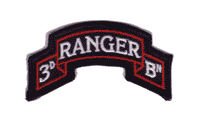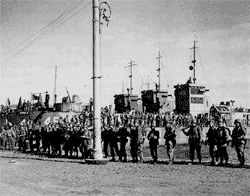3rd Battalion
 Active from 25 May, 1943 to 15 Aug, 1944
Active from 25 May, 1943 to 15 Aug, 1944
(per Ranger Memorial Fort Benning, GA)
At the end of it's small part in the Tunisian Campaign in late April 1943, the 1st Ranger Battalion entrained for Nemours, a tiny coastal port near the Western boundary of Algeria with French Morocco, and there, with volunteers from units then in North Africa, formed the Third, Fourth and reconstituted First Ranger Battalions under Colonel William Orlando Darby. The Third, cadred by A and B of the Old First, was led by Herman Dammer who had the legs and stamina of a Bactrian camel.
It opened Sicilian doors for Truscott's 3rd Division from Licata West to near Marsala. During this phase, the Battalion accounted for thrice its numbers in enemy casualties, at small cost to itself.
At one point, the Battalion topped a ridge to look down upon the left flank of a medium artillery battalion firing at elements of the Third Division. At once, the mortar squads set up and waited for orders to fire... and waited. And the more they waited, the more pissed off they became, having toted their abominable loads over endless mountains in Sicilian summer heat. Finally, one of the less-disciplined gunners let one "slip". Thereupon the other squads loosed ranging shots also, one of which hit the Italian artillery ammunition, detonating it with a horrendous roar, completely destroying the enemy unit (each gunner claimed it was "his" round that lit the dump). Shortly afterwards, as half the battalion advanced in extended order down a wide clear slope, an enemy convoy of trucks, cars, armored vehicles, and motorcycles came tearing along a metaled road which bisected the slope, and at that instant, had Rangers on either side of it. Most of the enemy column was brought to the ground.
Bypassing Agrigento, the Battalion continued in extended order all the way to Porto Empedocle, disposing of weak opposition here and there along the way. Here it met its first German opposition and took a hundred Germans, along with nearly a thousand Italian prisoners. Immediately after its occupation of the port, it came under the fire of "The Philly", the cruiser USS Philadelphia. Spelling out "USA" and "Yank" with barrels and bales on the docks, men of the Third coaxed Philly's spotter plane to the surface of the harbor, where it provided Colonel Dammer with a flight to the ship, and a longboat full of welcome Navy chow.
After nominal actions through Sciacia and Marsala, the Third joined the First and Fourth for rest and refit near the small town of Corleone which, although unknown to the Rangers then, subsequently became known to all as the nerve center of the Mafia.
Within a few days, a call came to Darby from the Third Division's General Truscott, for a battalion to secure his right flank as he fought up the North shore towards Messina. Offered the better rested First, Truscott demurred and specified the Third. The battalion then, with the aid of newly issued mules, toiled over the mountainous terrain all the way to Messina and entered that city, among the first of the Allies to do so, beating Montgomery, who was coming up the East shore, by a couple of days.
Now, it was back to Corleone, to prep for Salerno, where the Third, as part of Ranger Force, followed the Fourth and First into the beach at Maiori, on the extreme left flank of the main Allied forces at Salerno. The First and Third went quickly through the town and 12K up the road to Chiunzi Pass. The leading elements of the First left the road two thirds of the way, to occupy the heights dominated by Monte St. Angelo (1200m). The Third occupied Chiunzi Pass and the ridges to either side overlooking the main road from Naples to Salerno. The Rangers were the only units of the invading force which attained their initial objectives. This was because the Germans had taken over the Italian defenses, and fiercely contested the landings, at Salerno and Vietri sul Mare, against the U.S. Corps under General Dawley, the British Corps under General McCreery, and Two Commandos at Vietri. Opposition was such that, Mark Clark, commanding General of the 5th Army, contemplated withdrawal after the fourth day. Arguably, such may have happened except for the highly successful Ranger operation, which interdicted enemy travel on the principal road from Naples to Salerno.
The first to arrive at the Pass stood on a graveled shelf, gasping equally from the ascent and from the startling sight of a fire pulsing high up and far away in the dark. At dawn, the fire dims, and through the mist, a great mountain rises from the plain. It's the massive bulk of il Vesuvio erupting fire, smoke and ash as he's done since long before Etruscans, Greeks, Romans, and Italians peopled his slopes, and whom he's oft entertained with spectacular pyrotechnics. From time to time, he's gassed, suffocated, incinerated, and buried them. On September 9, 1943, he again has the stage! Brilliant beacon for the Luftwaffe, Allied bombers, and aiming point for the guns of the great fleet of warships accompanying the transports and landing craft riding calm seas off Salerno, and about to deposit 140,000 men upon the Continent.
With the Rangers was a unit of 4.2 Chemical mortars and both field artillery and Naval artillery observers. With the Plain of Naples, the main road curving along the narrow valley, through Pagani, Nocera Inferiore, Nocera Superiore, Cava, and around the feet of Monte Chiunzi and St. Angelo, in plain view, the Rangers and their observers directed mortar and Naval fire upon the roads from the first day, aided in no small measure by the initiative of Corporal Fox. Willie, on his own initiative, descended into Nocera, contacted demoralized Italians and obtained maps showing significant targets for gunfire. For the daylight hours, that road was "Closed". The Herman Goering division, charged with that flank, tried time after time to breach the thin Ranger lines spread over miles of ridges, but were defeated by the stubborn defenders which included, after a time, Paratroops and a 36th Division combat team. When the main Allied breakout occurred, it came through the Ranger positions, contrary to and much later than called for in the invasion plan.
The pass included a two-story farmhouse built right into the West wall of the Pass, with two of its exterior walls being part of the mountain's solid limestone. It eventually proved impervious to direct hits and sheltered quite effectively the forward HQ of The Force, a principal OP, and the aid station attended by Doc Shuster. Late in this action, Sergeant-Major Scotty Munro answered the phone, "Fort Shuster!" It remains so to those of the Third Battalion to this day.
After rest and refit in Naples and elsewhere, the Third joined the others, already in action on the Volturno, and against prepared German positions in greatly advantageous defensive emplacements in the mountains. The Rangers suffered many casualties during these mountain advances, and in late November, were sent back to Pozzuoli (near Naples) to refit and train for the landing at Anzio.
In mid-January, the Rangers landed against opposition at Anzio. After some nine days fighting, increasing opposition on the forward line of the beachhead, they were assembled for an infiltration to Cisterna di Littorio. The First and Third went through the German lines in single files on either side of the stream in the Pontano ditch, a part of the drainage system of the Pontine marshes which stretch northerly from Anzio to the Alban hills. Shortly before they attained Cisterna, the First and Third met their end, the same aided by a strange fortune! The Pontano ditch was designated by Kesserling, the German commander, as the dividing line between two divisions, which arrived at the front during the evening before the Ranger attempts on Cisterna. When the forces collided, the Rangers were mostly in two long files, dictated by the travel up the ditch, and had difficulty in assembling effectively. Major Alvah Miller, the Third commander was killed with the first shot, and the commander of the First disabled soon after. It gradually became clear that they were surrounded by vastly superior forces, and after a fight lasting late in the day, were finally cut in pieces, all attempts at aid (from the Fourth Battalion and the Third Division) failing.
Epilogue:
Revisionist historians, most in swaddling clothes when Rangers' ramps went down, and who, obviously plagiarizing one another, state that the Rangers were ambushed at Cisterna. Certainly that Kraut shouting fire orders to his battery as the Rangers stole past did not know such a trap was to be sprung. It is safe to conclude also that the hundreds of bivouaced Krauts just rolling out of their blankets at the first shots, as Rangers sprang shooting from the ditch, were ignorant of such an elaborate and clever plan. And if it were an ambush, how come it took all day for two divisions to cream about seven hundred? No, Carlo D'Estes got it right; the two divisions moving in the night before, dictated the result without any divination by the Krauts of the intended Ranger infiltration.
Likewise, a British writer suggests - preposterously! Darby stopped short of his objective - Pagani - at Chiunzi. The documentation shows conclusively that Darby's assigned objectives were those reached before daylight! To have continued to Pagani or Nocera would have been asinine and at odds with the whole purpose of the planned operations centered at Chiunzi Pass. Moreover, an analysis of this writer's reasons for his conclusions demonstrates a gross deficiency in map reading, stating critical heights and distances (as between the Pass and Nocera, for instance) wrongly by a factor of minus three, and quite ignores the significance of the rugged terrain between the Pass and Nocera demonstrated by the differences in the airline and road distance - one mile to 13 miles.
- Contributed by Carl Harrison Lehmann
1st & 3rd Battalion

(US Army Photo Public Domain)
- Dwight D. Eisenhower
Recommended Ranger Links
- Research Reading List
- Rangers in World War II (An excellent comprehensive account of all six Battalions by Ranger Robert W. Black)
- Darby Foundation
- Darby Legacy Project
 DESCENDANTS OF WWII RANGERS, INC
DESCENDANTS OF WWII RANGERS, INC 